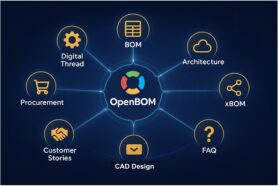
This a question that often comes up when engineers or manufacturing companies decide to step up in their data management game and bring some more data organization. In a typical “file-based” realm CAD files are the foundation of engineering data. They are used by engineers for design and in the majority of use cases (even today), the outcome of this work is a drawing. Together with assemblies and parts, they represent a foundation of engineering data management for the majority of engineering organizations and manufacturing companies. Engineers are doing pretty well with documents but sometimes can struggle with the organization of part numbers. The first question – are they the same? Should we simply use a document (file) name for the part number or do we need to manage both? If they are the same, how can we manage changes in parts when design (CAD files) changes are not needed? And how can we align changes in engineering documentation (eg. CAD files) that are corresponding to the same part number? What is the difference between version and revision and so on?
In this article, we aim to clarify the distinctions between file names and part numbers and provide best practices on how to organize them in a simple way. Let’s get started.
Document Name vs Part Number
One common misconception is equating document names with part numbers, leading to complexity and unfavorable outcomes. This oversimplification will create a lot of headaches for you in the future, although at the beginning it sounds like a really good and simple idea. It is essential to recognize that these are distinct entities serving different purposes. Document names typically refer to the titles or identifiers assigned to files, facilitating easy identification and retrieval. On the other hand, part numbers are unique identifiers assigned to physical or virtual components, enabling accurate identification and traceability throughout the product lifecycle. This is the right way to think about them. Not only to manage them separately but also to allow PLM applications to manage both (Documents and Parts) to support a separate lifecycle and change process for documents and parts.
Versions, Revisions for both Parts and Documents
Documents (Files) and Parts have different lifecycles and need to be managed separately. What does it mean for data organization how not to get confused? Documents are separate objects (can be managed as files or documents in cloud storage) and require proper identification. File names or document names can be used, but it is important to have them unique and to support a proper naming convention.
It is not always the case and many organizations are duplicating files in different folders. This is not a good practice and when you organize information you should avoid it. A proper file (or document) version must be assigned to identify all changes. Our recommendation is to capture all file (document) changes. Some of them can be done without immediate impact on parts and BOM structure.
Parts (Assemblies) are different objects and they represent the virtual definition of components in your design. In the simplest situation with a single BOM, all items will be managed as engineering items and BOMs. (PS. Later we will talk about multiple BOMs). While versions are iterations of changes in a particular file, Part changes, however, refer to alterations in physical or virtual components. Not differentiating between them can result in confusion, errors, and inefficiencies. By implementing distinct processes for managing versions, revisions, and part changes, organizations can ensure accurate tracking and effective change management.
Establishing Traceability and Organization
Parts/Assemblies and CAD files are two different objects and need to be managed separately. However, it is important to maintain traceability between documents (such as CAD files) and part numbers. Without these traceability mechanisms, you will have a hard time organizing changes that starts in parts and are later reflected in documents and vice versa – it will be really hard to manage the design, capture design changes, and later introduce Item and BOM updates.
This clarity enables seamless organization and streamlines PLM processes. By assigning unique part numbers to components and associating them with relevant documents, companies can easily trace the evolution of products, track dependencies, and make informed decisions during the design, manufacturing, and maintenance phases.
Conclusion:
It is vital to recognize that part numbers and document names/IDs are not the same. They represent separate entities within the engineering and manufacturing organization as well as the PLM implementation ecosystem, each with its own lifecycle and purpose. It is easy to think about how to not make differences between CAD files (documents) and Items/BOMs. It sounds simple and easy to do. However, without proper separation, clear identification, and connection, it will be very hard to manage a coordinated and connected process between two groups of changes – design and product lifecycle.
By implementing effective strategies for document naming and part numbering, organizations can achieve better results by organizing both document and part change management in a connected, yet separate manner. This approach promotes clarity, traceability, and improved efficiency throughout the product lifecycle. By simplifying PLM through clear definitions, distinct management of versions, revisions, and part changes, and establishing traceability between documents and part numbers, companies can enhance their overall PLM processes and drive successful product development.
Remember, effective document naming and part numbering serve as the foundation for streamlined PLM, paving the way for improved collaboration, reduced errors, and enhanced productivity.
REGISTER FOR FREE to check how OpenBOM can help you today.
Best, Oleg
Join our newsletter to receive a weekly portion of news, articles, and tips about OpenBOM and our community.










